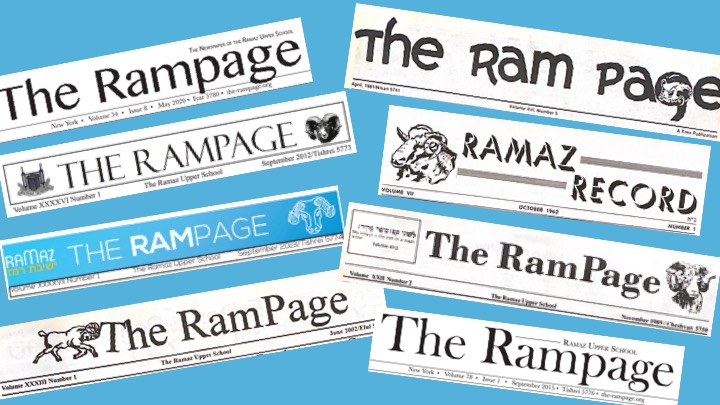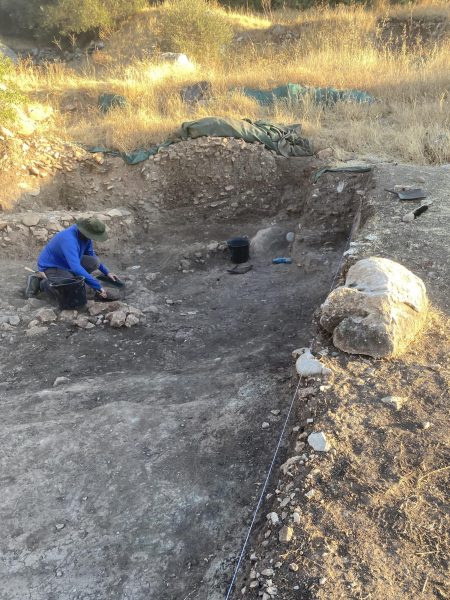The Rampage Through the Years
Reading back through old issues of The Rampage reveals a treasure trove of school history. Although the paper’s name has changed from The Ramaz Record to The Ram Page to The Rampage over the years, the newspaper has always been an outlet for student voices about the school and the world. The details of these articles have changed, but students have remained focused on many of the same overall topics, such as the G.O., dress code, privileges, and religion. The earliest issue in the school’s archives today dates back to 1961, but it’s likely that The Ramaz Record dates back to the 1940s, though these copies have yet to be found*.
Today, Ramaz students are known as the Rams, but this has varied over the years. In 1963 and 1993, The Ram Page referred to students as “Ramazies,” and in 1985, it termed them “Ramazers.” Boys’ Varsity teams were always known as the Rams, but in the past, the Girls’ Varsity teams were labeled “the Ewes” (female Rams). In October 1971, The Ram Page ran an opinion piece arguing that “due to male chauvinism, the Ewes have never received the recognition they deserve. While the Rams have had one dismal season after another, the Ewes have had a history of achievement.” The article characterized the name of the team as “another injustice…Anyone intrepid enough to cheer ‘Let’s go Ewes,’ is immediately laughed at.” The article advocates changing the Girls’ Varsity teams to be called the Ramazons. In some sense, the writer’s request was granted—the team was renamed: today, Boys’ and Girls’ Varsity teams alike are known as The Rams.
While sports teams have changed over time, The Rampage archives have revealed that some things—such as dances—have vanished entirely over the years. The December 1961 issue of The Ramaz Record noted an upcoming dance following a Ramaz vs. M.T.A doubleheader and the 1962 edition announced the upcoming Fall Frolic. In November 1963, The Record covered the freshman social event, Welcome Freshmen: “The nervous Freshmen were marched into the Lower School cafeteria where they met their Senior escorts and led the school in the singing of the Alma Mater. Supper and social dancing followed.”
Technological changes over time have affected The Rampage significantly. In the 1970s, the newspaper needed typists on staff, but based on the mastheads, this was no longer true by the ’80s. In October of 1995, The Ram Page first printed its email address, and by February of 2004, the paper listed a website as well. Past Co-Editor-in-Chief Aaron Wilson ’09 describes having a stash of recording devices for Ram Page writers to use for interviews. Wilson also recounts editing the paper “in the 7th floor computer lab which we called The Rampage treehouse. We spent hours on layout in Quark.” His Co-Editor-in-Chief Ellery Kauvar ’09 remembers the program as “not the most user friendly, even in 2009.” Now, students record interviews on their iPhones and type up articles on their laptops. Editors design the layout on Adobe InDesign, which, according to Julia Levi ’18, “can cause one to spiral down a dark hole from all of the hours spent adjusting margins.” Layout has persisted as one of the challenges of being Editor-in-Chief, as Andrew Lobel ’15 described InDesign as “an incredibly difficult program to use,” especially, as Oren Oppenheim ’16 said, when “working collaboratively on the print issue across three computers.” InDesign doesn’t lend itself to collaboration.
Throughout the years, The Rampage has consistently highlighted articles about the G.O. In December 1961, The Ramaz Record printed an unsigned letter to the editor asking if the G.O. was really necessary. The October 1962 issue featured a letter from the G.O. President urging more students to become G.O. members—the problem of needing to urge students to participate isn’t a new one. G.O. elections were covered in various issues, as was SFAC (Student Faculty Administration Committee), including minutes and summaries from meetings, as is still the case today. In February 2005, a news article announced that the G.O. was purchasing foosball and ping-pong tables for the auditorium.
Another common refrain was the question of “Privileges or Rights?” as entitled an opinion piece in May 1971. Ramaz students ask this question to this day, but it dates back to 1963, when “The Senior class appreciate[d] the opportunity to walk outside during lunch” and would “use our parole wisely.” The debate occurred again in a Point-Counterpoint article (the counterpart to today’s Pro/Con articles) in November 1993. In favor of privileges, it was suggested that “a well built freshman who has lived in Manhattan for his entire life would be much better off walking the streets than a short and skinny senior who lives in a suburb with a very low crime rate….Do juniors go away for Pesach vacation as irresponsible untrustworthy children, and return two weeks later as responsible and mature adults?”
Just like today, small changes in the dress code polarized the student body, generating opinionated articles in the paper. In September of 1990, The Rampage printed an editorial decrying a new rule in Preludes banning girls from wearing T-shirts, which sounds very similar to the ban added to Preludes at the beginning of 2017. The complaints in this editorial about the rule being vague echo student objections three years ago. In September 1993, Preludes was updated again and a student criticized Ramaz for not enforcing the rules about tzitizit and for its dress code not aligning with its philosophy. “Is the problem that female students wear halachically inappropriate clothing in school, or that female students purchase such clothing and feel a need to wear it?…The more that necklines are raised in school, the more they will plunge at parties. If all Ramaz can do is repress behavior, then they are simply babysitting, not educating.” In May 2003, the dress code was revised again, allowing students to wear sneakers for the first time. December 2004 brought a sweatshirt ban for girls midway through the year, but a petition successfully won girls the right to wear sweatshirts for the rest of the year.
The Rampage has also been a forum for students to discuss changes in the religious world, especially around davening—at Ramaz and in the broader world. Articles in May 1983 and May 1985 addressed decisions by the Conservative Movement to ordain female rabbis. The February 1990 issue featured two new Ramaz minyanim: the Women’s Tefillah Group and the Sephardic Minyan. In February 1995, the Women’s Tefillah Group was allowed to have Torah reading for the first time. In May 1993, The Rampage printed a letter to the editor from a female student who questioned why she wasn’t allowed to put on tallit and tefillin at Ramaz, but was allowed to at KJ. A news article in 2002 detailed a similar situation when a female student davened at KJ and Or Zarua in the mornings instead of at Ramaz in order to put on tallit and tefillin.
Freedom of the press has always been a question when it comes to The Rampage. Since the paper is a school newspaper, funded by the school, how much of a say should the administration have over its content? Jonathan Krasner ’84 remembers that his year as editor, “Our relationship with the administration was a little tense. Jeff Eilender and I published a survey about Ramaz students in the paper that showed that they were less observant, more questioning in their belief in God and the divinity of Torah she’b’al peh, and more liberal-minded on social issues than the administration would have liked. It was very embarrassing for the school, and in retrospect I feel bad that we caused them so much grief. But at the time we were indignant that they took umbrage. We were intrepid reporters simply trying to ferret out the truth.” When he was later hired as a Ramaz history teacher in 1991, “I came to admire some of the same administrators whose lives I made miserable, especially Rabbi Lookstein and Rabbi Bakst.” The article in question, printed in April 1983, was mentioned in a sermon at the Jewish Center, leading to a follow-up news article quoting several administrators and teachers who suggested that it should never have been printed in the first place (May 1983).
Sydney Sarachek ’14 said, “Our relationship with the administration was fine because we never really tried to broach any sensitive subjects….I think that was one of our biggest frustrations—there were so many interesting articles we could have written but because everything had to be vetted by the administration we couldn’t even really ever explore those topics.”
Rabbi Lookstein said, “We allowed kids to express themselves even when I wasn’t happy with the way in which they expressed themselves, and that’s a good thing,” referring to The Ram Page when he was principal. However, he also described The Ram Page as “[giving] him fits” and occasionally “muckraking.” Rabbi Lookstein explained that his concern about the paper was, “What’s the ‘Ram’ part of it as opposed to the ‘Page’ part of it? Does anyone who reads The Rampage come away with the idea that this is a Modern or Centrist Orthodox school?…Is there even any Torah in The Rampage?”
A newer challenge for the paper is generating readership. In the past, “people didn’t have the internet to read. People didn’t have their own cell phones to read. So when The Ram Page came out, people definitely read it,” said Evan Farber ’95. Today, ensuring that the paper is interesting enough that students pick it up—and continue reading it for more than a few seconds—is one of the greatest challenges for the Editors-in-Chief. Recent editors have tied the question of keeping students interested to the issue of being allowed to run more controversial articles. If The Rampage features information that students don’t already know, it will attract more readers. “It was hard to make the paper something people wanted to read given the limitations about what topics we could dive into,” said Sarachek ’14, “We had to get creative about what to cover so that we weren’t just writing about school assemblies in every issue.” Esti Beck ’19 also described one of her greatest challenges as “figuring out how to improve readership within the student body…My guess is that over time, as daily life became more digital, interest in reading or getting involved in print media declined.”
The focus of The Rampage has shifted throughout the years as well. In the past, the paper was much more politically-focused. Students seemed eager to express their opinions; there are articles and opinion pieces about world and school politics and several letters to the editor commenting on articles from previous editions. In the late ’80s and early ’90s, The Rampage reported consistently in 1990 on Soviet Jewry and Ramaz’s activism, including rallying in Midtown, marching to the UN, and trips to the Soviet Union. The same time period also featured reporting about the Israeli-Palestinian conflict and elections in the United States, including a pro-con article about Bush v. Clinton. In recent years, The Rampage has moved away from politics, focusing more on internal school events and has received almost no letters to the editor. Farber ’95 suggested that advances in communication and technology may be a possible reason for this shift, “If you want to say something to the whole student body, there are many other ways to do that now.”
As times change, The Rampage’s role in the student body has shifted. Now, students receive minute-by-minute updates on their phones and stay in constant contact with teachers and classmates via Schoology, email, text, and social media. However, despite all of these changes, The Rampage has remained an outlet for students to express opinions and ask questions about the school—and interestingly, many of these questions have not changed so drastically over the last 60 years.
*If you have old issues of The Rampage or information about the paper in the past, please contact rampage@ramaz.org.

Josephine Schizer has been writing for the Rampage since her freshman year and is excited to be serving as Co-Editor-in-Chief. Outside of Rampage, Josephine...




Daniel Wroblewski '81 • Jun 16, 2020 at 11:31 am
Very interesting and well-written article, especially about the religious nature of the school and the relationship with the administration.
It would be nice to learn what the administration, editors and students think is the purpose of the school paper (perhaps as a sophisticated extra-curricular to help students get into Ivy League schools), as well as to learn the clever ideas the students have in keeping it relevant in the Internet age.
In any event, I enjoyed reading. Well done.